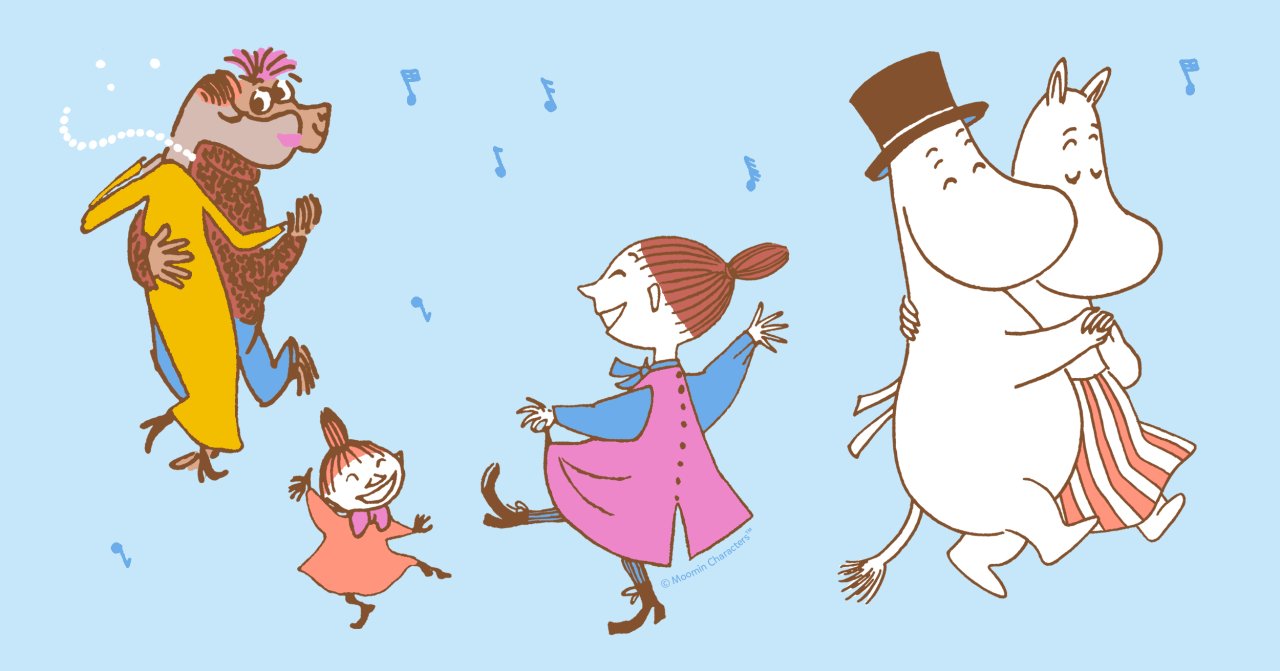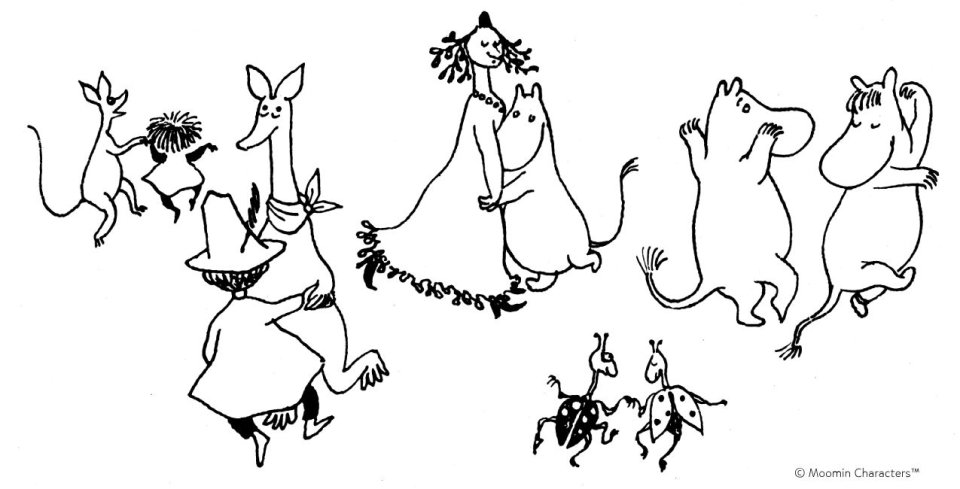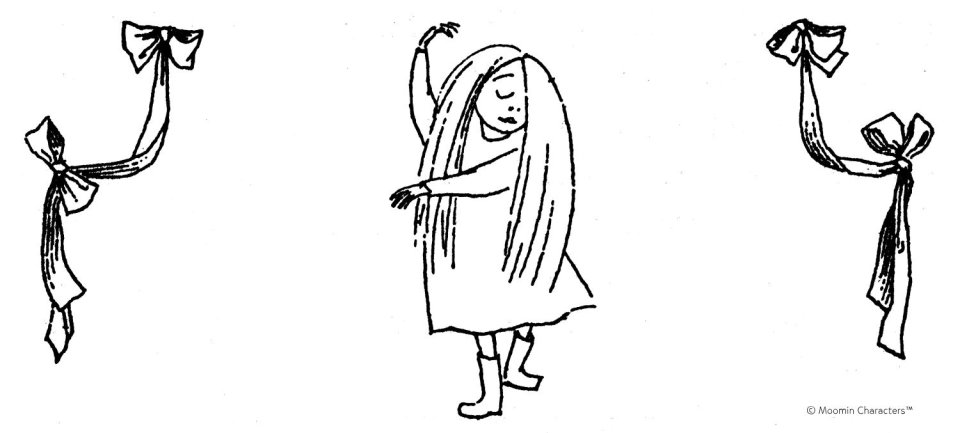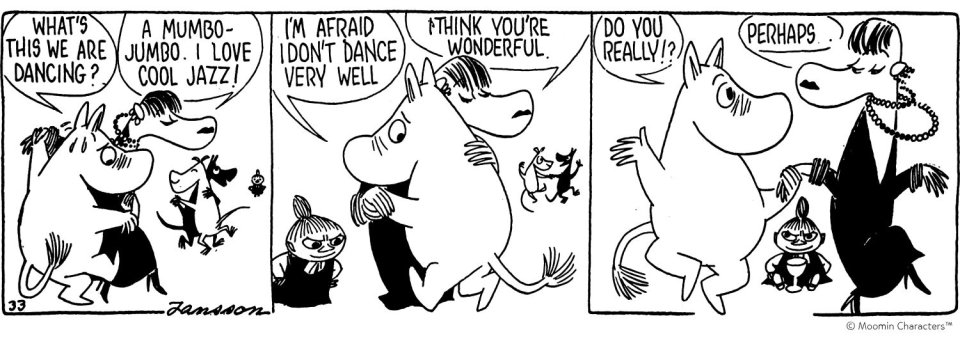Parties and having fun are an important part of life in Moominvalley, even in the face of catastrophe. This spirit of freedom and joy is often captured through dance. This article explores the theme of dancing in the Moomin stories!
The joy gained from shared moments is central to the Moomin stories. Tove Jansson really valued friends and family, and celebrations were a key way her community managed life during the World War. Parties, usually involving dancing, helped escape the sombre reality.
In old photos and videos, Tove is often seen dancing around at parties or on the rocks of her own island.
This playfulness and dancing as a way to express freedom and joy also made its way to Tove Jansson’s literature, including the Moomin stories. Throughout the books, the Moomin family and their friends attend and organise various parties. What we also learn from the Moomins is that you don’t need a special reason to have a celebration – or a little dance!
Dancing through danger: joy and togetherness
Comet in Moominland (1946) is a great example of the Moomins’ ability to hold on to small joys in the face of threats and worries. Snorkmaiden insists on visiting a dance party in the forest despite the approaching comet.
‘Oh, I want to dance! Couldn’t we dance?’ cried the Snork maiden, clapping her paws. ‘I haven’t been dancing for ages and ages.’
‘We haven’t time for that sort of thing now,’ said the Snork.
‘Perhaps we could buy some lemonade at that village stores,’ said Sniff. ‘I’m so thirsty.’
‘Anyway the path goes in exactly our direction,’ said Moomintroll.
‘We could just have a look at the dancing as we go by,’ suggested Snufkin.
– Comet in Moominland (1946)
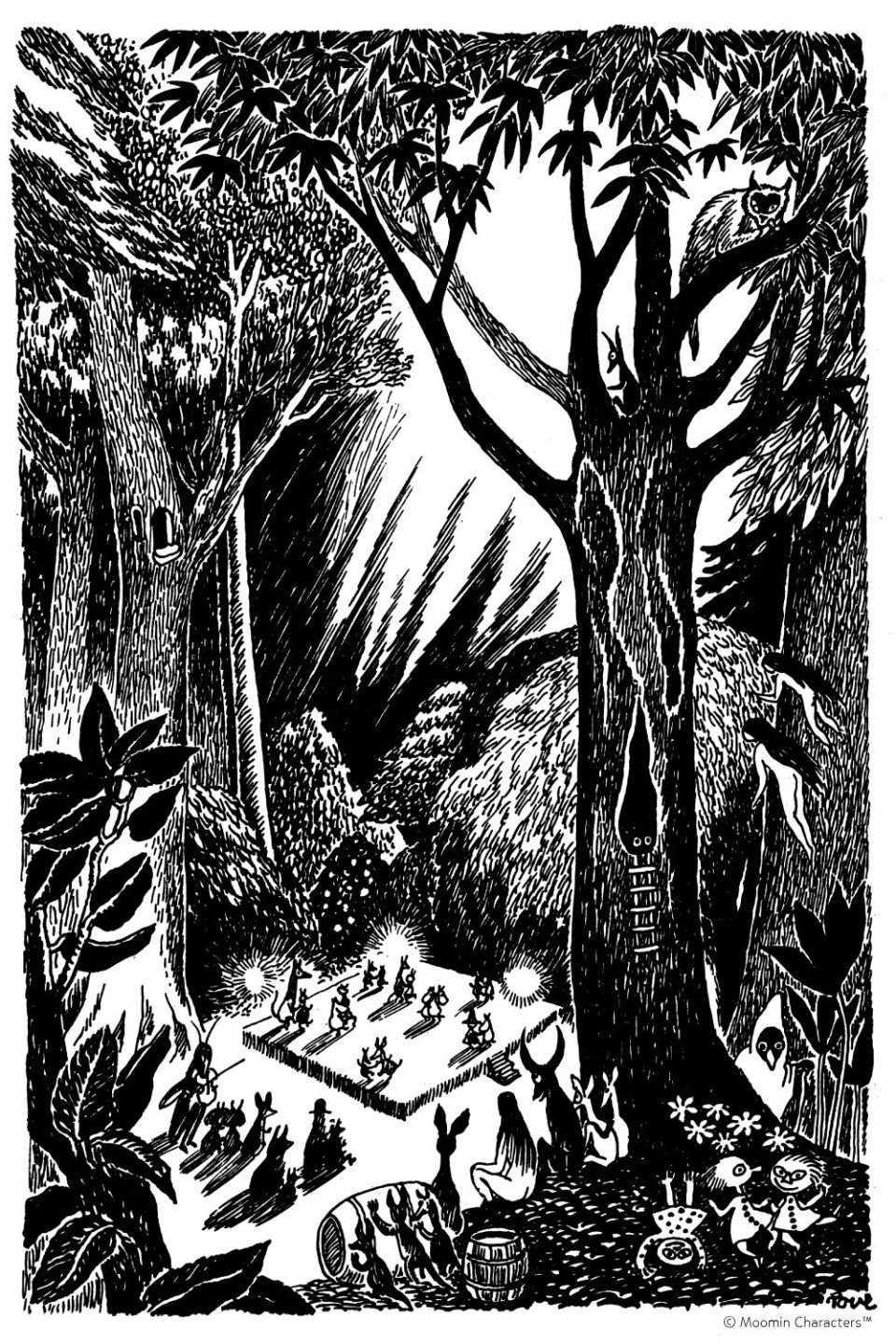
“Oh, I want to dance! Couldn’t we dance?”
The novel includes many illustrations of dancing; the first one depicts the whole forest party from afar, with different creatures embracing the dance floor in pairs.

“Even stiff-legged little mice ventured onto the dance floor”
In Finn Family Moomintroll (1948), the forest also comes alive with a grand celebration. Clusters of characters can be seen gathering for intimate parties around the forest, multiple joyful festivities echoing through the trees.
“Then Moominpappa carried the wireless out into the garden and tuned in to dance music from America, and in no time the valley was filled with dancing, jumping, stamping, twisting, and turning. The trees were thronged with dancing spirits, and even stiff-legged little mice ventured on to the dance floor.”’
– Finn Family Moomintroll (1948)
According to Sirke Happonen’s doctoral thesis on movement in the Moomin books (“Vilijonkka ikkunassa – Tove Janssonin Muumiteosten kuva, sana ja liike” from 2007), you can also spot differences in characters’ dancing styles – from ballerina-like Moomins to more artistic Fillyjonks and Mymbles.
Another fairly gloomy story, Moominvalley in November (1970), is made lighter through Mymble’s dance performance. Her movement, and her joy during it, is described in detail.
Mymble walked to the middle of the floor, looking very shy and self-conscious. Her hair reached to her knees, and it was obvious that the hair-washing had been a success. She nodded briefly to Snufkin and he started to play. He played very softly. Mymble raised her arms and circled with short, hesitant steps. Shoo, shoo, tiddledidoo, said the mouth-organ; imperceptibly the music moved into a tune, became more and more lively and Mymble quickened her steps, the kitchen was full of music and movement and her long red hair looked like flying sunshine. It was all so beautiful and jolly!
– Moominvalley in November (1975)
In Moominsummer madness (1954), Fillyjonk is excited about Midsummer and wants to celebrate dancing around a bonfire: not only a cultural reference to Nordic traditions but, again, dancing as a way of freeing oneself from duties and restraints.
‘What a night! Let’s build our bonfire of the notices! And dance round it until they’ve burned to ashes!’ —
The Fillyjonk was singing. She danced on thin legs around the bonfire and poked at the embers with a stick. ‘Never more my uncle,’ she sang. ‘And never more my aunt. I’ll never ask them any more! I don’t, I won’t, I shan’t!’
– Moominsummer Madness (1954)
There is another bonfire celebration in Moominland Midwinter (1957), which according to the book, is a thousand-year-old tradition for all the creatures that come out while the rest of the valley is asleep in the middle of winter.
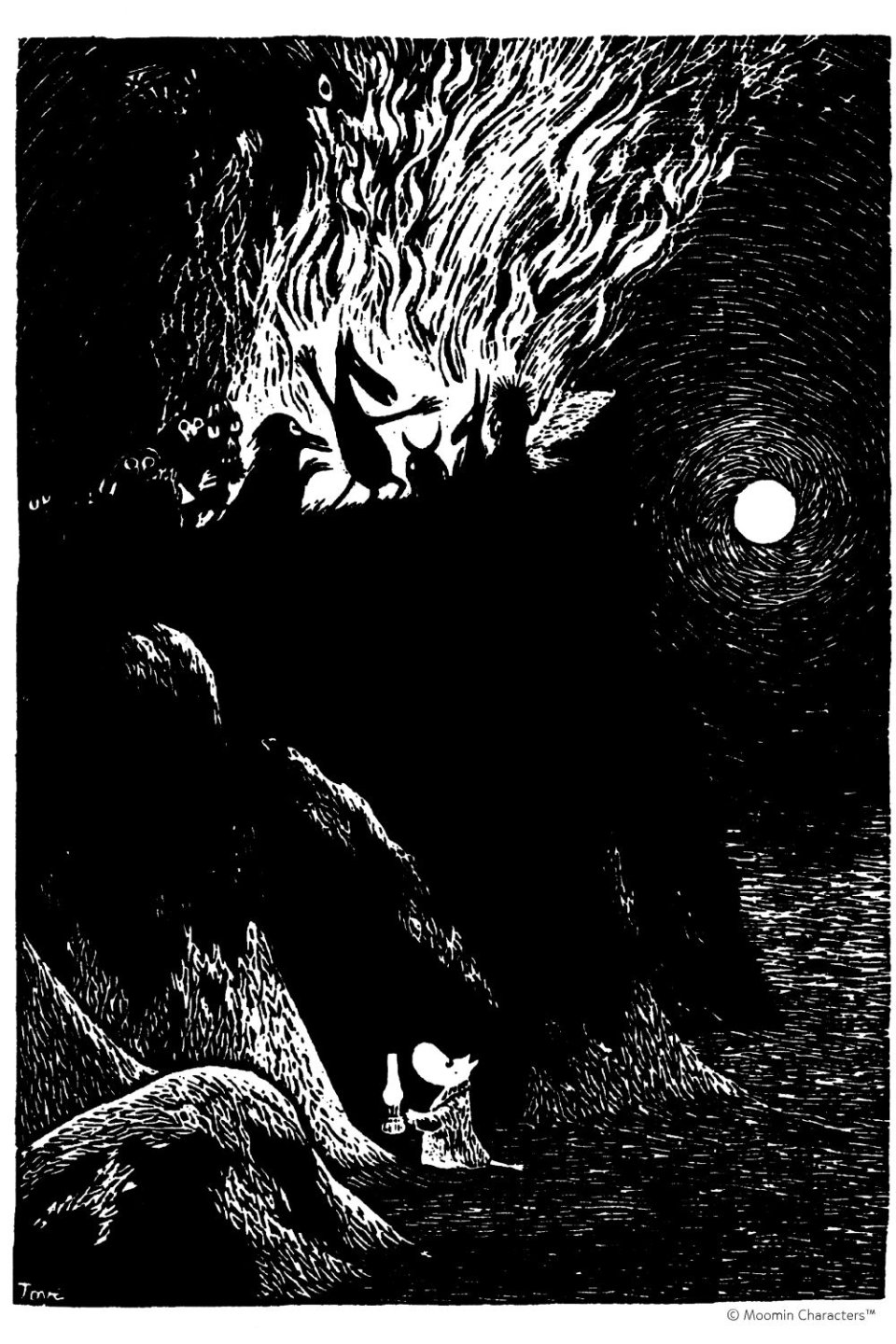
They looked towards the hilltop at the same time and saw a yellow flame rising against the sky. Tooticky had lit the bonfire. It wrapped itself in flames at once, from ground to top, it gave a roar like a lion and threw its reflection straight down on the black ice. A lonely little tune came running past Moomintroll: it was the invisible shrew who was a little late for the winter ritual. Small and great shadows were solemnly skipping round the fire on the hilltop. Tails were beginning to thud on drums.
– Moominland Midwinter (1957)

“The Groke was dancing!”
In Moominpappa at Sea (1965), delighted by the light of Moomintroll’s lamp on his nightly visit, even the iciest character expresses her feelings through moving freely.
She stared at the lamp, following a ritual of her own. After looking at it for a while she would begin to sing, or something that sounded like singing to her. It was a thin sound, something like humming and whistling together, and it penetrated everywhere, so that after a while Moomintroll felt that it was inside his head, behind his eyes, and even in his tummy.
At the same time she swayed slowly and heavily from side to side, waving her skirts up and down until they looked like dry, wrinkled bats’ wings.
– Moominpappa at Sea (1965)
Dancing through time: from swing to samba
The Moomin books have been translated into 60+ languages, many of which have also gotten several editions over the years. The dozens of versions show not only cultural variations but also differences relating to what was current at the time they were written or edited.
In the first 1946 version of the book Kometjakten (Comet in Moominland in Swedish), Snorkmaiden asks Moomintroll “Kan du dansa swing?” (“Can you dance swing?”) but in a later 1956 edition Mumintrollet på kometjakt, Snorkmaiden asks about Moomintroll’s mambo skills.
The 1951 English translation, on the other hand, brings up samba and in another Swedish version, Kometen kommer, from 1968, Snorkmaiden asks “Kan du dansa detdär nya du vet, vaddetnuheter?” (“Can you dance that new you know, whatisitcallednow?”).
Moomintroll, however, always likes the waltz best!
In the early versions of Comet in Moominland, Snufkin is illustrated dancing on his tiptoes when playing his harmonica, but in later versions he stands still on both feet.
Whether facing a looming comet, defying the mundane, or simply expressing joy, in Moominvalley, there’s always time for a dance! If you could join a dance party in Moominvalley, who would you want as your dance partner?
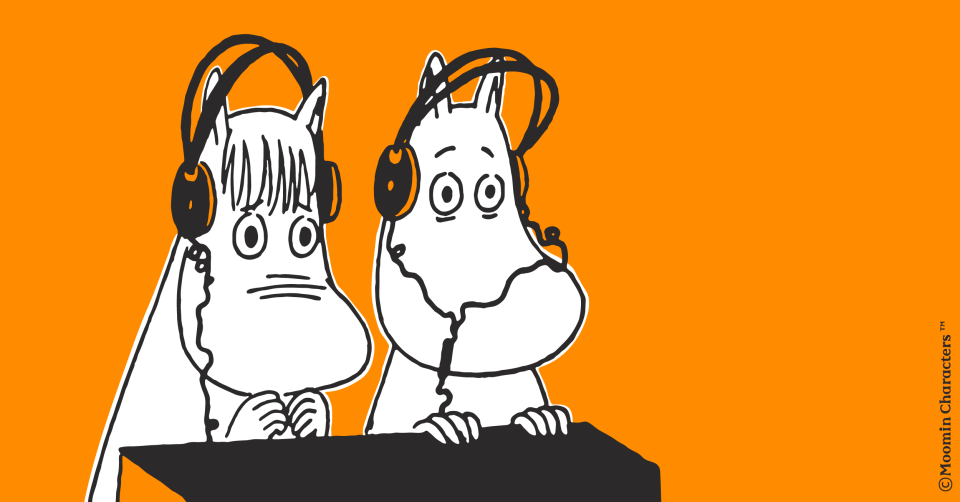
Moomin audio – Moominous sounds from all over the world
The Moomin stories have inspired numerous audio adaptations – tune in for Moominous audio bliss in several languages.

Barnes & Noble expands Moomin selection tenfold across the United States
Barnes & Noble expands stores carrying Moomin books and products in the US. Moomin products are now available in 260 stores nationwide!
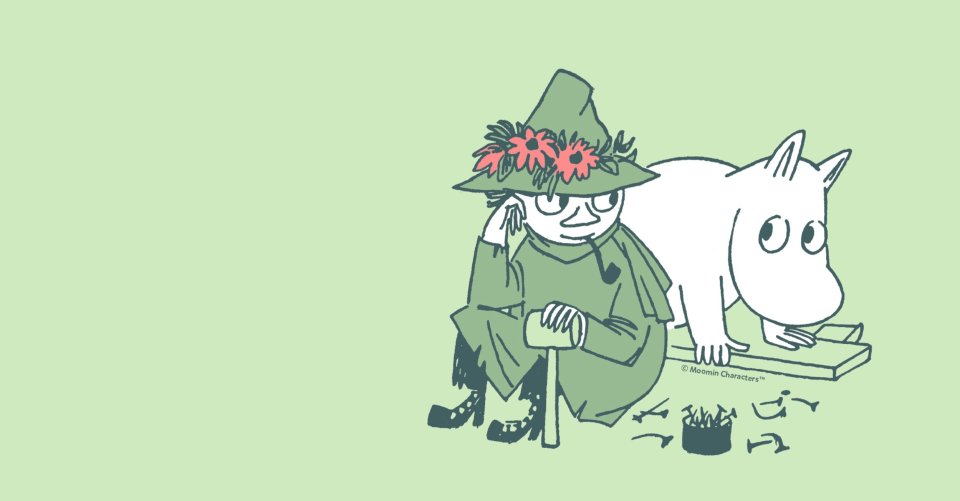
Snufmin – The story of Snufkin and Moomintroll
Snufkin and Moomintroll, “Snufmin”, have long been a fan favourite. Dive into the journey of this iconic friendship in this article!
